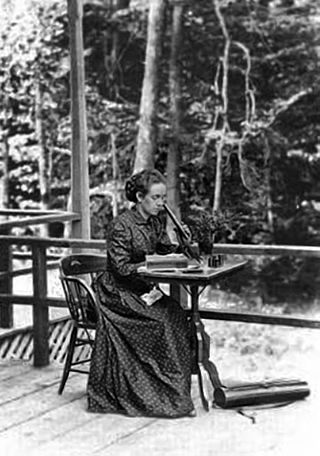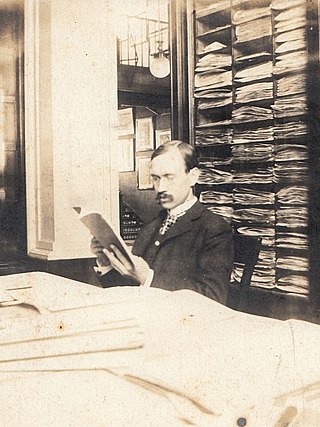
Lichenology is the branch of mycology that studies the lichens, symbiotic organisms made up of an intimate symbiotic association of a microscopic alga with a filamentous fungus.

William Starling Sullivant was an early American botanist recognized as the foremost authority on bryophytes in the United States.

Bryology is the branch of botany concerned with the scientific study of bryophytes. Bryologists are people who have an active interest in observing, recording, classifying or researching bryophytes. The field is often studied along with lichenology due to the similar appearance and ecological niche of the two organisms, even though bryophytes and lichens are not classified in the same kingdom.
William Alfred Weber was an American botanist and lichenologist. He was Professor Emeritus at the University of Colorado at Boulder and former curator of the University of Colorado Museum Herbarium.
Charles Christian Plitt was a botanist and lichenologist. Species of lichens that have been named in Charles Plitt's honor are: Pyrenula plittii R.C.Harris, Xanthoparmelia plittii (Gyelnk) Hale, and Pertusaria plittiana Erichsen.
The Bryologist is a peer reviewed scientific journal specializing in bryology. It is published quarterly by the American Bryological and Lichenological Society (ABLS). It began as a department of The Fern Bulletin devoted to the study of North American mosses. Its first editor was Dr. Abel Joel Grout, who intended the bulletin to be "enabling any one at all interested in mosses to get some knowledge of these plants without excessive labor or expense ... the editor will also try to identify for subscribers difficult specimens accompanied by notes and return postage."

Annie Morrill Smith was an American botanist and bryologist from Brooklyn. She was a largely self-taught amateur who became important to the Sullivant Moss Society. From 1906 to 1911 she acted as the sole editor of The Bryologist. She also published a number of important genealogical books. Born Annie Elizabeth Morrill, she was a daughter of Cynthia (Langdon) and Henry Edwin Morrill, M.D. She was educated at Packer Collegiate Institute, and in 1880 married Hugh Montgomery Smith, a physician who died unexpectedly in 1897.

Elizabeth Gertrude Britton was an American botanist, bryologist, and educator. She and her husband, Nathaniel Lord Britton played a significant role in the fundraising and creation of the New York Botanical Garden. She was a co-founder of the predecessor to the American Bryological and Lichenological Society. She was an activist for the protection of wildflowers, inspiring local chapter activities and the passage of legislation. Elizabeth Britton made major contributions to the literature of mosses, publishing 170 papers in that field.

William Louis "Bill" Culberson was an American lichenologist.
The International Association for Lichenology (IAL) is an organisation that encourages the understanding of lichens and lichenology, and promotes their study and conservation worldwide. It unites lichenologists across the globe, as well as national and regional organisations into one group. It is affiliated to the International Union of Biological Sciences (IUBS). The IAL organises field courses and excursions, as well as symposia which are the biggest events in lichenology on the international level. The 8th International Symposium will be held in Helsinki, Finland, in August 2016.

Carolyn Wilson Harris was vice president of the Sullivant Moss Society during 1904–1905 and charge of the Lichen Department from 1901–1905. She also wrote many articles on various lichen genera and species. She was known for being an indefatigable worker, and did much to popularize the study of lichens; her help was always given freely and cheerfully to those who applied to her for assistance in their studies.
Inez Maria Haring was an American botanist and plant collector, best known for her work in bryology as the Assistant Honorary Curator of Mosses at the New York Botanical Garden beginning in 1945.

Abel Joel Grout (1867–1947) was an American bryologist, an expert on pleurocarpous mosses, and founding member of the Sullivant Moss Society.

Margaret Sibella Brown was a Canadian bryologist specializing in mosses and liverworts native to Nova Scotia. Although lacking formal scientific training, she has been recognized for her contributions to bryology and as an authority on the mosses and liverworts of Nova Scotia. Samples she collected are now housed at major herbaria in North America and Europe.

George Newton Best was an American bryologist, expert on moss taxonomy, and second president of the Sullivant Moss Society.

John Michael Holzinger was a German-born American bryologist, expert on the bryoflora of Colorado, and third president of the Sullivant Moss Society.
John Walter Thomson Jr. (1913–2009) was a Scottish-born American botanist and lichenologist, sometimes referred to as the "Dean of North American Lichens".
Thomas Hawkes Nash III is an American lichenologist. His research is about the biology and ecology of lichens, and the effects of air pollution on plants and lichens. He is known as an authority on the family Parmeliaceae. During his long career at the Arizona State University, he helped develop the lichen herbarium into a world-class collection with over 100,000 specimens representing more than 5000 species. In 2010, the year of his retirement, he was awarded the Acharius Medal for lifetime achievements in lichenology, and the following year had a Festschrift published in his honor.

Edward Blanchard Chamberlain was a botanist and bryologist that specialized in the flora of Maine. He served as President of the Sullivant Moss Society from 1905 to 1907.
Mary Farnham Miller was an American botanist who specialized in bryology, the study of moss and lichen. She was one of the earliest members of the Sullivant Moss Society, and worked at the Smithsonian National Museum of Natural History.












